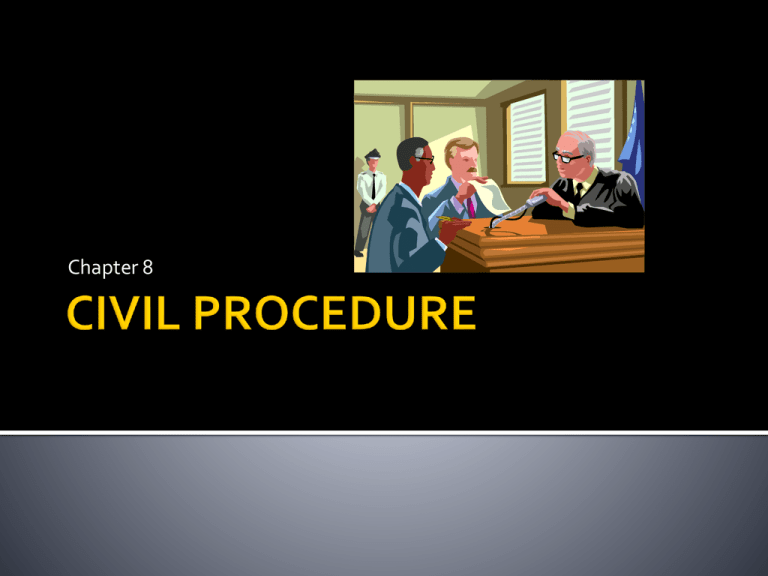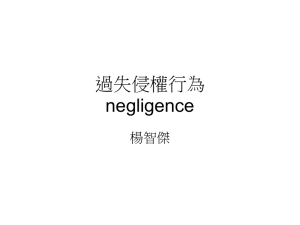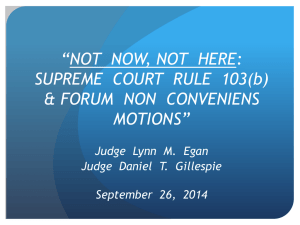CIVIL PROCEDURE - pre trial
advertisement

Chapter 8 A civil action relates to an act or omission that infringes the rights of a person, group or government instrumentality and seeks to return the party whose rights have been infringed to their original position before the harm occurred. The aim of civil action is to restore the party whose rights have been infringed back to the position they were in before the act or omission occurred. This can be done through a civil remedy such as damages. Plaintiff – party bringing civil action/the party whose rights have been infringed. Defendant – the party who is alleged to have carried out the wrong action eg negligence. Standard of proof – Balance of Probability (means which version of the facts is most probably correct) Burden of proof – lies with the plaintiff Civil actions include: Negligence Breach of contract Trespass Defamation Nuisance Family law Inheritance trusts Children under 18 can sue another person through a ‘next friend’ Children can also be sued – extent of their liability depends on child’s maturity and the behaviour expected of a child at that age. When a person takes responsibility for the actions of another person Example: employer/employee relationship If a person is negligent towards another person during the course of their employment. When a group of people can be included together as the plaintiff in a claim against a group or company – this is known as class action or representative action One or more of the group with common grievance bring an action, representing the claim for each other member of the group. Slater and Gordon represented 1000 people in 1995 representative action – salmonella poisoning from contaminated peanut butter Aim To inform both parties of information relating to the case Plaintiff informs the defendant about the claim being made against them Defendant informs the plaintiff about their defence ( This allows the parties to discover whether it is worthwhile proceeding with the case) It might also lead to an out of court settlement between the parties meaning their do not need to go to court. Cost, trauma and inconvenience of going to court would be avoided. Contact the other party Solicitor – gives legal advice to their clients and prepare the documents necessary for a matter to proceed. The solicitor will advise the plaintiff of their legal right and their chance of winning. Barrister – briefed by solicitor – asked to act on behalf of the solicitor’s client. Barrister investigates the law and appear in court. Solicitor sends a letter of demand Informs the other party of the nature of the claim against them and suggests the compensation or other remedy sought. Sets time limit Contains the details of the claim made by the plaintiff against the defendant and matters being raised by way of defence by the defendant. Aim State the issues of their case Compel each party state material facts Gives the court a written record Saves the court time and expense Assists in out of court settlement Must be as brief as possible Point of law can be raised Should not contain evidence of fact claimed Time limits The writ or originating motion with endorsement of claim Notice of apearance (including couterclaim if appropriate) Statement of claim (if not endorsed on the writ or originating motion) Statement of defence Reply Further and better particulars Summarise pages 419 to 428 Questions 12 to 23 Plaintiff will issue a writ against the defendant It explains that an action is being taken against them Informs about the place and mode of trial (whether their is a jury) Writ sent to court – copy sent to plaintiff and defendant Includes cause of action and remedy Usually indorsed on the writ If not indorsed on the writ the Statement of claim must be served within 30 days or receiving the notice of appearance. Gives details of the claim An originating motion can be used when there is little dispute over the facts Filing of the writ – signifies commencement of proceedings Valid for one year – can be extended if problem serving This indicates the defendant will defend case against them The writ will give a specific time for the defendant to enter an appearance Time limit (not less then 10 days if the writ is served in Vic – 21 days elsewhere in Australia) If the defendant does not enter an appearance within the time limit the plaintiff can obtain judgement Gives information about the defence Provides plaintiff with defendant’s version of the facts Shows which facts are admitted and which facts are denied Plaintiff may issue a reply if they agree with the defendant on an issue or confirm some material facts. Each party may demand better particulars, or further and better particulars of the other party’s claim. If not received ‘summons in chamber’ DEFENDANT - Counterclaim Allows parties to get further information on matters that might remain unclear. Pleadings – gain info about the claim Discover – discover detail about the facts of the case Interrogatories - 60 days – written responses to questions. Saves time and expense in court reduces the element of surprise – if not answer ‘notice of default’ Notice of discovery – disclose all relevant documents – affidavit of documents – can request copy (videotape, audiotape, disc, film or other recording) Discovery by oral examination – consented in writing to be put orally in court Medical examination and provision of hospital and medical reports Notice of admission of facts Expert evidence Offer of compromise Directions hearings Certificate of readiness Pre- trial conference Mediation and arbitration











